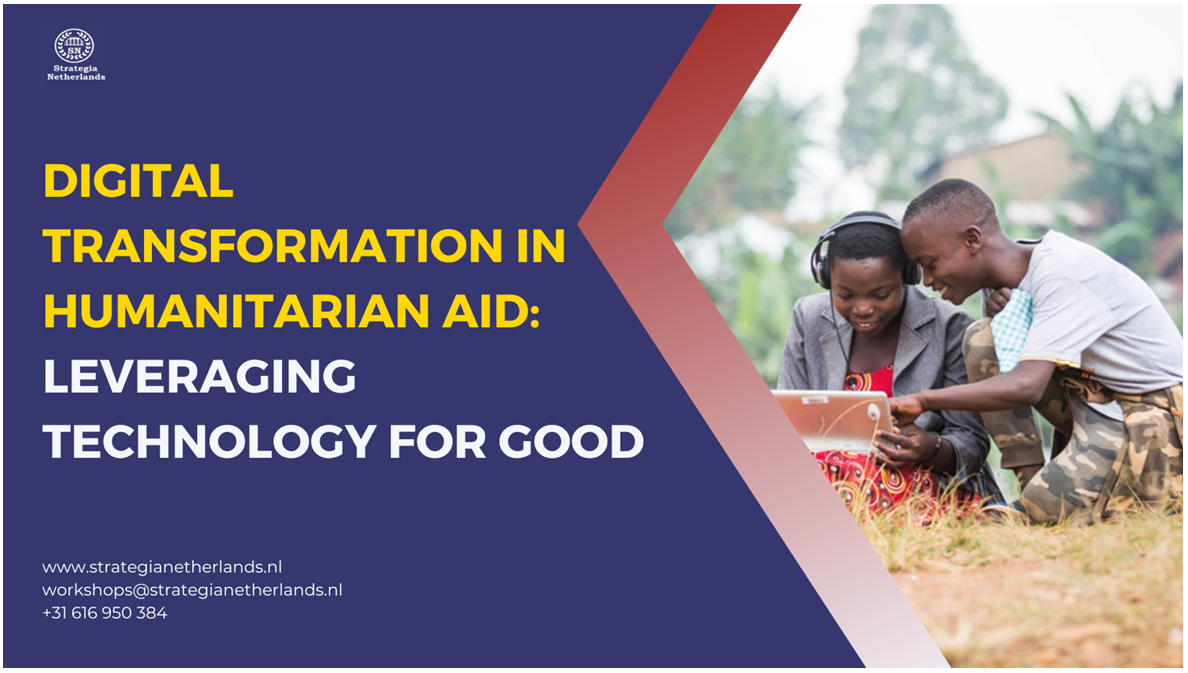- September 19, 2023
- Posted by: strategia
- Category: blog posts

The world is rapidly evolving, and so is the field of humanitarian aid. Over the past few years, digital transformation has played a pivotal role in reshaping how humanitarian organizations respond to crises, from natural disasters to conflicts. This transformation has been driven by the adoption of artificial intelligence (AI) and other digital technologies that enable more efficient and effective humanitarian action.
In this blog post, we will explore the opportunities and challenges presented by digital transformation in humanitarian aid. We’ll delve into how AI is revolutionizing the sector, the potential benefits it offers, and the ethical considerations that come with its use.
The Role of Artificial Intelligence in Humanitarian Aid
Artificial intelligence, or AI, is at the forefront of this digital revolution in humanitarian aid. But what exactly is AI in this context? AI is a collection of technologies that combine data, algorithms, and computing power to perform complex tasks. In essence, it allows machines to learn, reason, and make decisions based on data.
AI in humanitarian aid consists of two main elements: knowledge-based systems and machine learning systems. Knowledge-based systems leverage existing human expertise to solve problems, while machine learning systems improve their performance through experience.
Digital Technologies for Preparedness, Response, and Recovery
Digital transformation in humanitarian aid is fundamentally changing the way organizations approach their missions, encompassing three main dimensions: preparedness, response, and recovery.
Preparedness: AI technologies analyze vast datasets, providing vital insights into potential risks before a crisis unfolds. Predictive analytics, a product of AI, calculates and forecasts natural disasters, displacement, famines, and health emergencies. For instance, the International Federation of Red Cross and Red Crescent Societies (IFRC) employs the Forecast-based Financing program, which uses meteorological data and market analysis to allocate resources swiftly for early action implementation.
Response: Advanced AI technologies, such as deep learning, natural language processing, and image processing, enable quicker and more accurate classification of social media messages during crises. This assists humanitarian actors in responding promptly to emergencies. For instance, the Emergency Situation Awareness platform monitors Twitter content to provide information about natural disasters as they occur.
Recovery: In protracted crises, AI can facilitate engagement between humanitarian organizations and affected communities. Tools like AI-powered chatbots streamline services and provide information to affected populations. For example, the International Committee of the Red Cross (ICRC) developed the Trace the Face tool, which uses facial recognition technology
to help refugees and migrants find missing family members.
The Opportunities and Risks of AI in Humanitarian Aid
While AI offers tremendous potential in humanitarian aid, it also poses significant risks and ethical challenges. Here are some critical considerations:
Risks of “Surveillance Humanitarianism”: The growing use of AI for data collection may inadvertently increase the vulnerability of those in need by exposing them to privacy violations and surveillance.
Techno-Solutionism: Relying solely on AI solutions without addressing broader issues may not be as effective as anticipated. Context-specific solutions that involve local communities are often more successful.
Techno-Colonialism: The adoption of AI must be done with sensitivity to avoid imposing
technological solutions on communities without their input and consent.
The “Do No Harm” Imperative**
Humanitarian organizations must adhere to the principle of “do no harm” when deploying AI in their operations. This means carefully assessing the potential risks and benefits and ensuring that AI systems do not expose affected populations to additional harm or discrimination.
Data Privacy and Transparency
Data privacy is paramount when deploying AI in humanitarian aid. Organizations must obtain informed consent when collecting and processing personal data and prioritize data security.
Transparency and accountability are essential, and grievance mechanisms should be in place to address any adverse impacts.
In conclusion, digital transformation, driven by AI and other technologies, is revolutionizing humanitarian aid. While these advancements offer unprecedented opportunities to improve preparedness, response, and recovery efforts, they also come with ethical responsibilities.
Humanitarian organizations must ensure that technology serves as a force for good, prioritizing the well-being and dignity of affected populations in all their digital endeavors. The “do no harm” principle should guide every step of this transformative journey, ensuring that technology truly leverages the power of digital transformation for the benefit of humanity
